What is Hair Transplant?
A hair transplant is a surgical procedure used to treat hair loss and baldness, which involves moving hair follicles from one part of the body, called the donor site, to a bald or balding part of the body known as the recipient site. This procedure is primarily used to treat male pattern baldness but can also be applied to restore eyelashes, eyebrows, beard hair, chest hair, pubic hair, and to fill in scars caused by accidents or surgery such as face-lifts and previous hair transplants.

Hair Transplant in Turkey: A Comprehensive Overview
Hair transplant in Turkey is a highly popular procedure designed to restore hair growth in areas affected by thinning or baldness. Renowned for its high-quality healthcare and affordable prices, Turkey has become a leading destination for hair transplant surgery.
The process begins with a comprehensive consultation and medical evaluation to determine the patient’s suitability and the best technique for the transplant. Common methods include Follicular Unit Extraction (FUE) and Direct Hair Implantation (DHI). Skilled surgeons perform the procedure using advanced techniques in state-of-the-art facilities to ensure natural-looking results.
Hair Transplant Steps

The process of a hair transplant involves several key steps, which can vary slightly depending on whether you’re undergoing a Follicular Unit Transplantation (FUT) or Follicular Unit Extraction (FUE). Here is a general overview of the steps involved in both procedures:
Pre-Procedure
- Consultation: The first step is a thorough consultation with a hair transplant surgeon to discuss goals, evaluate hair loss, and decide on the best treatment approach.
- Pre-operative Assessment and Planning: The surgeon will examine the donor and recipient areas, discuss the patient’s medical history, and plan the hairline or areas to be covered.
Day of the Procedure
- Preparation of the Donor Area: The hair in the donor area (usually the back of the head) is trimmed short to facilitate the removal of grafts.
- Local Anesthesia: Local anesthesia is applied to the donor area (and later the recipient area) to minimize discomfort during the procedure.
For FUT
- Strip Removal: A strip of scalp is surgically removed from the donor area, and the area is then sutured closed.
- Follicular Unit Preparation: The strip is dissected under a microscope into individual follicular units or grafts.
For FUE
- Follicle Extraction: Individual follicles are extracted one by one from the donor area using a special micro punch tool.
Common Steps for FUT and FUE
- Recipient Area Preparation: The recipient area is prepared by making tiny incisions or slits where the grafts will be placed.
- Transplantation: The harvested follicular units are carefully placed into the incisions in the recipient area, following the natural growth direction of the patient’s hair.
- Post-operative Care: The surgical sites are cleaned and covered with bandages. Detailed post-operative care instructions are given to the patient.
Post-Procedure
- Recovery: Patients can usually return home the same day. Swelling, redness, and some discomfort may occur but should subside within a few days. Stitches (in the case of FUT) are removed in about two weeks.
- Hair Growth: Transplanted hair will begin to grow within 3 to 4 months after the procedure. It may take up to a year to see the full results of the transplant.
Follow-up
- Follow-up Visits: Follow-up visits with the surgeon may be scheduled to monitor the progress of the transplanted hair and to ensure the healing process is going smoothly.
Types of Hair Transplant
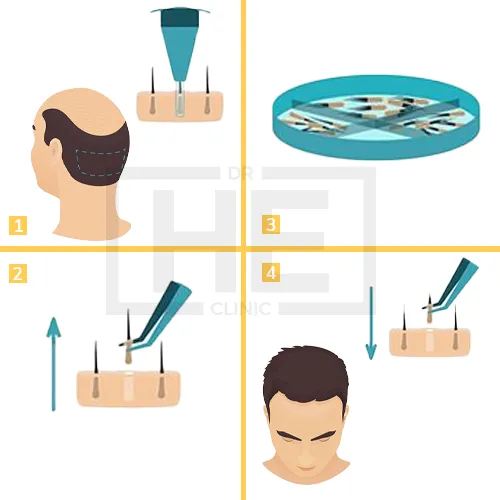
Follicular Unit Transplantation (FUT): Also known as strip harvesting, this method involves removing a strip of skin from the donor area, usually the back of the head, under local anesthesia. The strip is then dissected into individual follicular units, which are small groups of hair follicles, under a microscope. These units are then transplanted into tiny slits in the recipient area.
Follicular Unit Extraction (FUE): This technique involves harvesting individual hair follicles directly from the scalp without removing a strip of tissue. The surgeon uses a small micro punch tool to remove the follicles. The extracted follicles are then inserted into the recipient area. FUE is less invasive than FUT, leading to a quicker recovery time and less scarring.
Recovery After Hair Transplant

Immediate Post-Operative Period
- First Few Days: Swelling, mild pain, and some bleeding at the transplant and donor sites are common. Your surgeon might prescribe pain medication, antibiotics to prevent infection, and anti-inflammatory medications to manage swelling.
- Bandages: The bandages over the transplant site are usually removed a day or two after the surgery.
- Sleeping Position: It’s recommended to sleep with your head elevated on pillows to reduce swelling.
First Week
- Washing: You may be instructed on how to gently wash your scalp a few days after the procedure. It’s crucial to follow these instructions carefully to avoid dislodging grafts.
- Scabbing and Itching: Scabbing around the transplant sites is common, along with some itching. Avoid scratching the area to prevent dislodging the transplanted hair follicles.
- Swelling: Swelling may peak around the eyes and forehead but should begin to subside within a few days. Using cold compresses can help reduce swelling.
First Month
- Shedding: The transplanted hair will likely shed within the first few weeks. This is normal and part of the growth process. The roots remain and will grow new hair.
- Activity: Avoid strenuous activities and exercise for at least a few weeks to prevent increased swelling and bleeding.
Long-Term Care
- Hair Growth: New hair growth can be expected within 3-4 months after the surgery, but it can take up to a year to see the full results.
- Follow-Up Visits: Attend all scheduled follow-up appointments so your surgeon can monitor your progress.
Tips for a Smooth Recovery
- Follow all post-operative instructions provided by your surgeon.
- Keep the scalp clean and moisturized if recommended.
- Avoid exposing the transplant site to direct sunlight for extended periods.
- Refrain from smoking and drinking alcohol, as these can hinder the healing process.
- Be patient with the growth process. The final results take time.

Need Help? Contact Us!
7/24 Obesity Help Desk
Hair Transplant Turkey Cost 2025
In 2025, the cost of hair transplants in Turkey can vary significantly depending on the technique used and the extent of the treatment required. Here’s a summary of the costs based on different sources and techniques:
- For the FUE technique, the median pricing ranges between 1,800 Euros and 3,500 Euros. The cost can be around 2,000 Euros for 1,000 grafts and approximately 2,500 Euros for 2,000 grafts .
- On average, a hair transplant in Turkey can cost between $2,500 and $5,000, and these packages are often all-inclusive .
- The average price of a hair transplant in Turkey is estimated to be between £1,500 and £5,000 .
- An all-inclusive hair transplant package in Turkey is typically priced at around €2,300, with costs ranging from a minimum of €1,100 to a maximum of €5,000 .
- Specific packages like the DHI Package range from €3,500 to €4,000, Sapphire FUE Package from €3,300 to €3,500, Fast Recovery Package from €3,750 to €4,000, and the Stem Cell Package from €4,750 to €5,000 .
| Region | Average Hair Transplant Cost |
 Turkey Turkey | $2,000 – $5,000 or more |
 USA USA | $9,000 – $14,000 or more |
 Canada Canada | $9,000 – $12,000 or more |
 UK UK | £9,000 – £10,000 or more |
 Australia Australia | AUD 10,000 – AUD 15,000 or more |
 Germany Germany | €8,500 – €12,000 or more |
 France France | €8,500 – €11,000 or more |
Why does Hair Transplant Cost in Turkey Cheap?
- Exchange rate: Favorable exchange rates for foreign currencies relative to the Turkish lira can make procedures even cheaper for international patients.
- Standardized procedures: Many Turkish clinics employ standardized protocols and techniques for common procedures like Hair Transplant, achieving efficiency and cost savings.
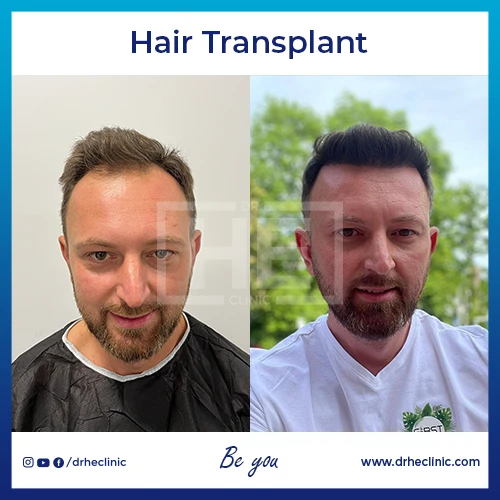
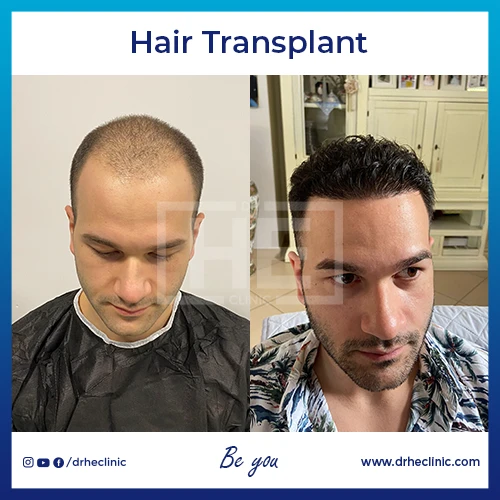
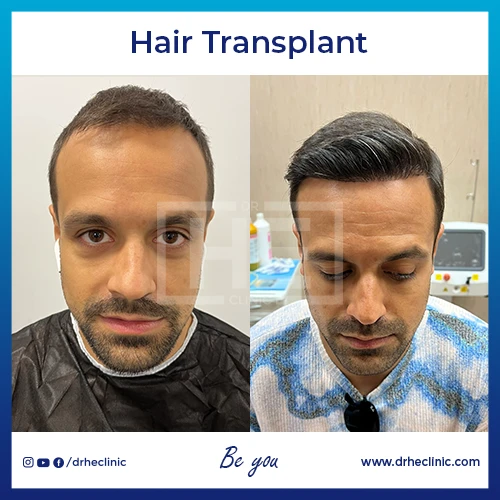
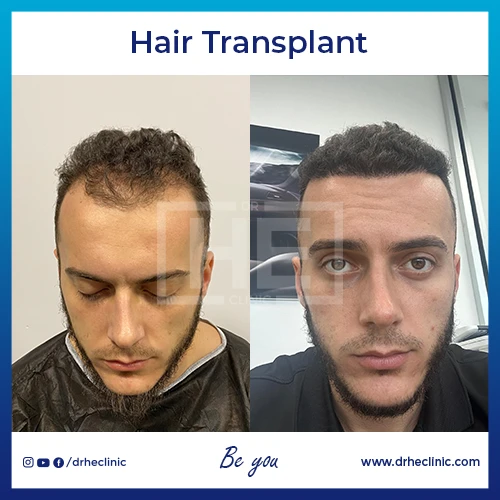

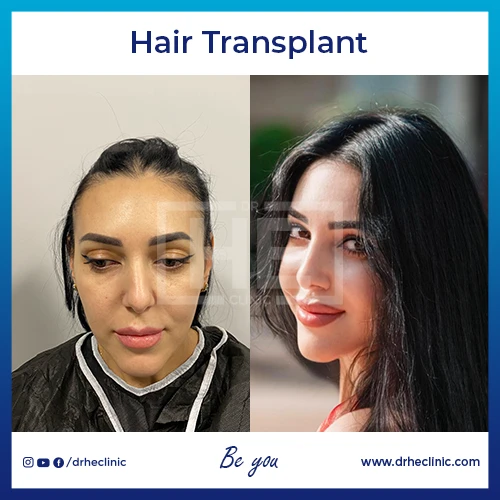
Hair Transplant Before and After Photos
Submit your request for access to before and after photos to see actual patient results from our many cosmetic procedures and treatments at Dr. HE Clinic.
Hair Transplant Turkey Reviews

Posted on
Truspilot
Posted on
TruspilotIs it Safe To Have A Hair Transplant in Turkey?
Having a hair transplant in Turkey is generally considered safe, especially when you choose a reputable clinic and experienced surgeon. Turkey is renowned for its advanced medical facilities and skilled hair transplant specialists, making it a popular destination for patients from around the world seeking hair restoration solutions.
Frequently Asked Questions AboutHair Transplant Surgery
Does Health Insurance Pay for the Hair Transplant?
In most cases, health insurance does not cover hair transplant surgery because it is considered a cosmetic procedure. Health insurance typically pays for medical procedures that are deemed medically necessary, which means they are needed to treat or diagnose a health condition that could lead to more serious medical issues if left untreated. Since hair transplants are performed to improve appearance rather than to treat a medical illness, they usually do not qualify for insurance coverage.
Is Hair Transplant Painful?
Hair transplant surgeries, such as Follicular Unit Transplantation (FUT) and Follicular Unit Extraction (FUE), are generally performed under local anesthesia, which means that the scalp is numbed. Therefore, during the procedure itself, patients should not feel pain. However, the experience of pain can vary from person to person, and some discomfort may be felt when the local anesthetic is initially injected into the scalp.
Is There a Scar After The Hair Transplant?
The presence and visibility of scars after a hair transplant depend on the method used for the procedure and various individual factors, including the patient’s healing abilities and the skill of the surgeon.
QUALITY CERTIFICATES

















Posted on
Truspilot